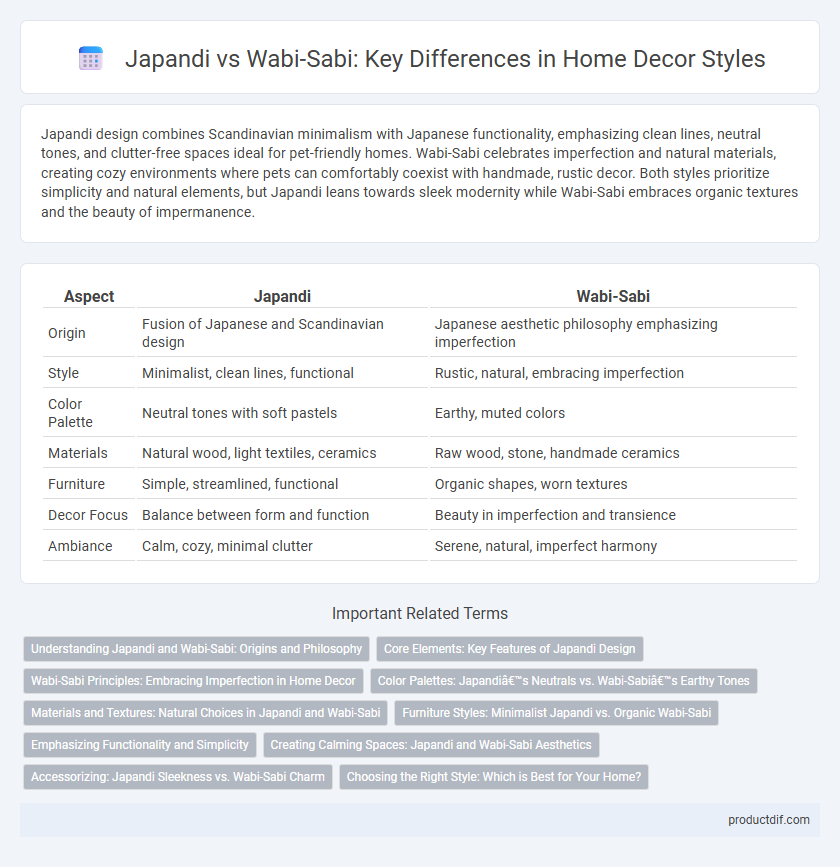Japandi design combines Scandinavian minimalism with Japanese functionality, emphasizing clean lines, neutral tones, and clutter-free spaces ideal for pet-friendly homes. Wabi-Sabi celebrates imperfection and natural materials, creating cozy environments where pets can comfortably coexist with handmade, rustic decor. Both styles prioritize simplicity and natural elements, but Japandi leans towards sleek modernity while Wabi-Sabi embraces organic textures and the beauty of impermanence.
Table of Comparison
| Aspect | Japandi | Wabi-Sabi |
|---|---|---|
| Origin | Fusion of Japanese and Scandinavian design | Japanese aesthetic philosophy emphasizing imperfection |
| Style | Minimalist, clean lines, functional | Rustic, natural, embracing imperfection |
| Color Palette | Neutral tones with soft pastels | Earthy, muted colors |
| Materials | Natural wood, light textiles, ceramics | Raw wood, stone, handmade ceramics |
| Furniture | Simple, streamlined, functional | Organic shapes, worn textures |
| Decor Focus | Balance between form and function | Beauty in imperfection and transience |
| Ambiance | Calm, cozy, minimal clutter | Serene, natural, imperfect harmony |
Understanding Japandi and Wabi-Sabi: Origins and Philosophy
Japandi style blends Japanese minimalism and Scandinavian functionality, emphasizing clean lines, natural materials, and tranquility. Wabi-Sabi embraces imperfection and impermanence, rooted in Japanese aesthetics that highlight simplicity, rustic beauty, and the passage of time. Both philosophies cherish natural elements but differ in approach: Japandi seeks harmony through refined design, while Wabi-Sabi finds beauty in authenticity and asymmetry.
Core Elements: Key Features of Japandi Design
Japandi design blends Japanese minimalism with Scandinavian functionality, emphasizing clean lines, natural materials, and a neutral color palette to create a serene, clutter-free space. Key features include handcrafted wooden furniture, muted tones of beige and gray, and a balance of simplicity with cozy textures such as linen and wool. This style prioritizes functionality and harmony, incorporating elements like low-profile furnishings and open spaces to promote calm and mindfulness.
Wabi-Sabi Principles: Embracing Imperfection in Home Decor
Wabi-Sabi principles celebrate the beauty of imperfection by incorporating natural materials, asymmetry, and weathered textures into home decor, creating a serene and authentic atmosphere. This philosophy emphasizes simplicity, minimalism, and the appreciation of transience, often showcased through handcrafted, rustic objects that tell a story. Embracing Wabi-Sabi in interior design fosters a sense of calmness and mindfulness, transforming spaces into harmonious retreats that highlight the imperfect charm of everyday life.
Color Palettes: Japandi’s Neutrals vs. Wabi-Sabi’s Earthy Tones
Japandi color palettes emphasize soft neutrals such as warm beiges, creamy whites, and muted grays that create a calm, minimalist aesthetic. Wabi-sabi embraces earthy tones like rich browns, oxidized greens, and deep rusts, reflecting natural imperfections and organic textures. These distinct color choices define Japandi's refined simplicity versus Wabi-sabi's rustic and imperfect beauty.
Materials and Textures: Natural Choices in Japandi and Wabi-Sabi
Japandi design emphasizes smooth, light woods such as oak and bamboo paired with soft linens and minimalist ceramics, creating a clean and serene texture palette. Wabi-Sabi celebrates raw, tactile materials like weathered wood, rough clay, and linen with imperfections, embracing natural wear and asymmetry. Both styles prioritize natural elements but Japandi leans toward refined simplicity while Wabi-Sabi highlights rustic authenticity and organic variation.
Furniture Styles: Minimalist Japandi vs. Organic Wabi-Sabi
Japandi furniture emphasizes clean lines, functional design, and a minimalist aesthetic often featuring light woods like oak and bamboo, creating a sleek yet warm environment. In contrast, Wabi-Sabi furniture embraces irregular shapes, natural imperfections, and raw materials such as reclaimed wood and stone, promoting a sense of organic simplicity and authenticity. Both styles prioritize simplicity, but Japandi leans towards refined minimalism while Wabi-Sabi highlights rustic, handcrafted charm in home decor.
Emphasizing Functionality and Simplicity
Japandi and Wabi-Sabi both emphasize functionality and simplicity through minimalist design and natural materials. Japandi blends Japanese and Scandinavian aesthetics, prioritizing clean lines, practical furniture, and clutter-free spaces for serene living. Wabi-Sabi celebrates imperfection and organic forms, focusing on simplicity with rustic textures and understated elegance that highlight the beauty of impermanence.
Creating Calming Spaces: Japandi and Wabi-Sabi Aesthetics
Japandi and Wabi-Sabi aesthetics both emphasize creating calming spaces through minimalism and natural elements, blending functionality with tranquility. Japandi combines Japanese simplicity and Scandinavian coziness, using clean lines, muted color palettes, and natural wood to evoke warmth and serenity. Wabi-Sabi celebrates imperfection and transience, incorporating rustic textures, organic shapes, and understated decor that foster a peaceful, mindful environment.
Accessorizing: Japandi Sleekness vs. Wabi-Sabi Charm
Japandi accessorizing emphasizes sleekness through minimalist, functional pieces crafted from natural materials like bamboo and light wood, creating a harmonious blend of Japanese simplicity and Scandinavian warmth. Wabi-Sabi charm embraces imperfections with handcrafted, rustic accessories such as weathered ceramics and asymmetrical vases that highlight natural textures and the beauty of aging. Both styles value natural elements but diverge in execution--Japandi leans toward refined elegance, while Wabi-Sabi celebrates authenticity and imperfection.
Choosing the Right Style: Which is Best for Your Home?
Japandi combines Japanese minimalism with Scandinavian functionality, emphasizing clean lines, natural materials, and neutral tones for a sleek, modern look. Wabi-Sabi embraces imperfection and natural aging, celebrating rustic textures, asymmetry, and organic forms to create a tranquil, lived-in atmosphere. Selecting between Japandi and Wabi-Sabi depends on whether you prefer structured simplicity or a more textured, imperfect aesthetic that highlights natural beauty.
Japandi vs Wabi-Sabi Infographic

 productdif.com
productdif.com